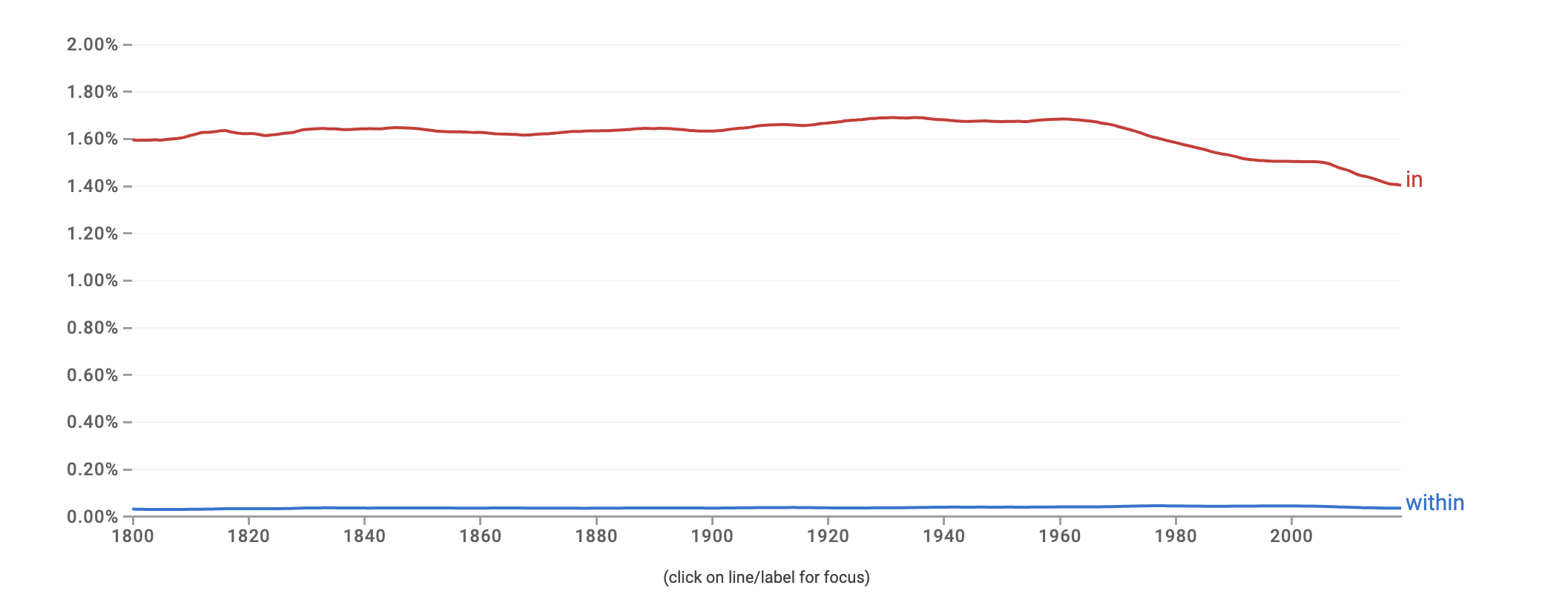- "Within" is a preposition indicating a location or position inside a particular area or limits. It can also express a time frame, referring to an event or action occurring before the end of a specified period.
- "In" is a preposition indicating location, position, or inclusion within a space or limits. It signifies being inside or surrounded by something, whether physically, temporally, or conceptually.
🔑 She found her keys in the pocket of her coat, relieved to finally locate them after searching for a while.
When to use "within" and "in"
"Within" and "in" are both prepositions, but their usage depends on the context:
Within:
- Indicates a Limit or Range: Use "within" when referring to a limit, range, or a specific timeframe.
Example sentences: The package will be delivered within two days. The bookstore is located within the shopping mall.
In:
- Indicates Location or Inclusion: Use "in" when referring to a location, position, or inclusion within a space or limits.
Example sentences: The cat is hiding in the box. She is currently studying in the library.
In summary, use "within" when emphasizing limits, ranges, or timeframes, and use "in" when indicating location, position, or inclusion within a space or context.
To differentiate "in" and "within," think of boundaries. "In" refers to being inside a specific location or container, while "within" indicates inside a particular time frame or set limits. Connect "in" with physical space and "within" with temporal or conceptual confines.
The use of "within" and "in" over time
The use of "within" and "in" differ greatly. "In" is used more frequently than "within."

Example sentences for "within"
- She found the key within the drawer.
- The answer lies within the pages of that book.
- The beauty of nature is often discovered within the smallest details.
- Our meeting is scheduled within the next hour.
- The solution to the problem is likely hidden within the data.
- Happiness comes from within, not from external circumstances.
- The treasure was buried deep within the cave.
- The truth lies within the heart of the matter.
- The success of the project depends on collaboration within the team.
- He felt a sense of peace within the tranquil surroundings.
Examples from the web
"Within 24 hours of this happening Katie Hopkins posted vile remarks on Twitter about how long the people of Scotland live for." - The Guardian
Example sentences for "in"
- She is waiting for you in the lobby.
- There's a surprise for you in the box.
- Birds often build their nests in trees.
- The book you're looking for is in the library.
- We will meet you in the conference room.
- He excelled in his studies and received top honors.
- In times of trouble, friends often provide support.
- The car is parked in the garage.
- She works in marketing for a multinational corporation.
- In the darkness, a faint light guided their way.
Examples from the web
"Let us know in the comments section below." - The New York Times
FAQs
What is the difference between within and between?
"Within" denotes elements existing inside a boundary or group. "Between" signifies the relationship or comparison of entities existing in separate boundaries or groups. "Within" addresses internal connections, while "between" addresses relationships across distinct entities or categories.
Is within inside or outside?
"Within" implies inside. It denotes a location, condition, or relationship existing inside a specified boundary or framework. Something within is contained or situated inside, emphasizing an internal position or connection rather than an external one.
Is it on or in the inside?
"In" is used to convey being enclosed within something, emphasizing an internal position. "On" typically suggests a surface or exterior location. So, "in the inside" is redundant, as "in" alone conveys the sense of internal placement.
Summary
In summary, mastering the distinctions between 'within' and 'in' is essential for precise language use. 'In' signifies internal placement, while 'within' refers to existence within a defined boundary. Avoid redundancy, like 'in the inside,' and employ these terms judiciously for effective communication.

Want to sound like a native speaker?
Engram’s AI-powered grammar checker makes your English sound like a native speaker’s, suggesting natural English expressions on top of fixing grammar, spelling, punctuation, word order, and vocabulary.

References:















